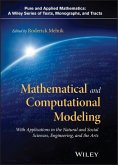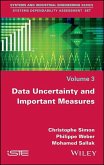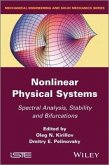Geographical Modeling
Cities and Territories
Herausgeber: Pumain, Denise
Geographical Modeling
Cities and Territories
Herausgeber: Pumain, Denise
- Gebundenes Buch
- Merkliste
- Auf die Merkliste
- Bewerten Bewerten
- Teilen
- Produkt teilen
- Produkterinnerung
- Produkterinnerung
The modeling of cities and territories has progressed greatly in the last 20 years. This is firstly due to geographic information systems, followed by the availability of large amounts of georeferenced data - both on the Internet and through the use of connected objects. In addition, the rise in performance of computational methods for the simulation and exploration of dynamic models has facilitated advancement. Geographical Modeling presents previously unpublished information on the main advances achieved by these new approaches. Each of the six chapters builds a bibliographic review and…mehr
Andere Kunden interessierten sich auch für
![Mathematical and Computational Modeling Mathematical and Computational Modeling]() Mathematical and Computational Modeling108,99 €
Mathematical and Computational Modeling108,99 €![Mathematical Modeling in the Social and Life Sciences Mathematical Modeling in the Social and Life Sciences]() Michael OlinickMathematical Modeling in the Social and Life Sciences206,99 €
Michael OlinickMathematical Modeling in the Social and Life Sciences206,99 €![Mathematical Modelling Mathematical Modelling]() Seyed M MoghadasMathematical Modelling110,99 €
Seyed M MoghadasMathematical Modelling110,99 €![Data Uncertainty and Important Measures Data Uncertainty and Important Measures]() Christophe SimonData Uncertainty and Important Measures170,99 €
Christophe SimonData Uncertainty and Important Measures170,99 €![Nonlinear Physical Systems Nonlinear Physical Systems]() Oleg N KirillovNonlinear Physical Systems207,99 €
Oleg N KirillovNonlinear Physical Systems207,99 €![The A to Z of Mathematics The A to Z of Mathematics]() Thomas H SidebothamThe A to Z of Mathematics195,99 €
Thomas H SidebothamThe A to Z of Mathematics195,99 €![Modern Advanced Mathematics for Engineers Modern Advanced Mathematics for Engineers]() Vladimir V MitinModern Advanced Mathematics for Engineers208,99 €
Vladimir V MitinModern Advanced Mathematics for Engineers208,99 €-
-
-
The modeling of cities and territories has progressed greatly in the last 20 years. This is firstly due to geographic information systems, followed by the availability of large amounts of georeferenced data - both on the Internet and through the use of connected objects. In addition, the rise in performance of computational methods for the simulation and exploration of dynamic models has facilitated advancement. Geographical Modeling presents previously unpublished information on the main advances achieved by these new approaches. Each of the six chapters builds a bibliographic review and precisely describes the methods used, highlighting their advantages and discussing their interpretations. They are all illustrated by many examples. The book also explains with clarity the theoretical foundations of geographical analysis, the delicate operations of model selection, and the applications of fractals and scaling laws. These applications include gaining knowledge of the morphology of cities and the organization of urban transport, and finding new methods of building and exploring simulation models and visualizations of data and results.
Hinweis: Dieser Artikel kann nur an eine deutsche Lieferadresse ausgeliefert werden.
Hinweis: Dieser Artikel kann nur an eine deutsche Lieferadresse ausgeliefert werden.
Produktdetails
- Produktdetails
- Verlag: Wiley
- Seitenzahl: 256
- Erscheinungstermin: 28. April 2020
- Englisch
- Abmessung: 236mm x 157mm x 20mm
- Gewicht: 522g
- ISBN-13: 9781786304902
- ISBN-10: 1786304902
- Artikelnr.: 58296839
- Herstellerkennzeichnung
- Libri GmbH
- Europaallee 1
- 36244 Bad Hersfeld
- gpsr@libri.de
- Verlag: Wiley
- Seitenzahl: 256
- Erscheinungstermin: 28. April 2020
- Englisch
- Abmessung: 236mm x 157mm x 20mm
- Gewicht: 522g
- ISBN-13: 9781786304902
- ISBN-10: 1786304902
- Artikelnr.: 58296839
- Herstellerkennzeichnung
- Libri GmbH
- Europaallee 1
- 36244 Bad Hersfeld
- gpsr@libri.de
Denise Pumain is Professor at the University of Paris I Pantheon-Sorbonne (France), co founder of the CNRS Geographie-cités laboratory and Director of Cybergeo: European Journal of Geography. She participates in the development of numerous models for an evolutionary theory of cities.
Introduction ix
Denise PUMAIN
Chapter 1. Complexity in Geography 1
Denise PUMAIN
1.1. A first bifurcation in the epistemology of geographic modeling 3
1.1.1. "Vertical" explanations for the "science of places, not people" 4
1.1.2. "Horizontal" explanations for the science of the spatiality of
societies 5
1.1.3. The discussed status of modeling 7
1.2. Modeled regularities 10
1.2.1. Proximity and distances 11
1.2.2. The scale 15
1.2.3. Concentration and accumulation: geographical inequalities and
scaling laws 19
1.2.4. Spatial change and trajectory dependence 21
1.2.5. Territorial drifts, space-time compression, and globalization 25
1.3. Conclusion 29
Chapter 2. Choosing Models to Explain the Dynamics of Cities and
Territories 31
Lena SANDERS
2.1. Introduction 31
2.2. Explaining by reasons or laws: choosing an epistemological framework
32
2.3. The modeling approach: diversity of models 36
2.4. Explaining through statistical relationships or mechanisms 38
2.5. Choosing the level of abstraction for the phenomenon to be explained:
general versus particular 41
2.6. Choosing the level of abstraction for the model: stylized or
realistic, KISS or KIDS 44
2.6.1. Modes of representation of space: from a stylized space to a
realistic space 45
2.6.2. Formalizing spatial mechanisms: from stylized to realistic 48
2.7. Conclusion 50
Chapter 3. Effects of Distance and Scale Dependence in Geographical Models
of Cities and Territories 53
Cécile TANNIER
3.1. Three fundamental principles for modeling cities and territories 55
3.1.1. Effects of distance 57
3.1.2. Effects of scale dependence 58
3.2. Role of distance in spatial simulation models 61
3.3. Modeling scale dependence 76
3.3.1. Scale dependence as a result of processes acting at different scales
77
3.3.2. Scale invariance for the description of geographical phenomena 83
3.3.3. Scale dependence as a generative mechanism for simulated spatial
configurations 88
3.4. Conclusion 93
Chapter 4. Incremental Territorial Modeling 95
Clémentine COTTINEAU, Paul CHAPRON, Marion LE TEXIER and Sébastien
REY-COYREHOURCQ
4.1. The map and the territory 96
4.1.1. Modeling as one map: selection and schematization 96
4.1.2. The representation of territory as an input of the model 100
4.1.3. The representation of territory as an output of the model 102
4.2. Generality and specificity: explaining by ways of geographical models
106
4.2.1. Historical contingency and non-ergodicity 106
4.2.2. General/specific/singular 109
4.3. Incremental territorial modeling 110
4.3.1. Identifying the object, scale, configuration, and stylized facts 111
4.3.2. Gathering the different theoretical explanations 112
4.3.3. Hierarchizing the interaction processes between agents 113
4.3.4. Hierarchizing the interaction processes between agents and their
environment 114
4.3.5. Implementing mechanisms and their formal alternatives 115
4.3.6. Combining, simulating, and comparing 116
4.4. Challenges and limits of multi-modeling 117
4.4.1. The combinatorial curse 118
4.4.2. Human and technical costs 118
4.4.3. Subjectivity in the choice of building blocks 119
4.4.4. Comparing models of different structures 119
4.4.5. Sharing and accumulation of knowledge 121
4.5. Conclusion 121
Chapter 5. Methods for Exploring Simulation Models 125
Juste RAIMBAULT and Denise PUMAIN
5.1. Social sciences and experimentation 126
5.2. Geographical data and computer skills 127
5.3. New generation simulations 130
5.3.1. A virtual laboratory: the OpenMOLE platform 131
5.3.2. The SimpopLocal experiment: simulation of an emergence in geography
134
5.3.3. Implementation of SimpopLocal, from NetLogo to OpenMOLE 137
5.3.4. Calibration and validation 139
5.4. Other examples of OpenMOLE applications: network-territory interaction
models 143
5.5. Perspectives 147
5.5.1. Methods 147
5.5.2. Tools 148
5.6. Conclusion 149
Chapter 6. Model Visualization 151
Robin CURA
6.1. Introduction 151
6.2. Visualization as modeling 153
6.2.1. Visualization as a tool for interdisciplinarity 155
6.2.2. Visualization and reproducibility 160
6.2.3. Visualizing a model means learning 162
6.3. Visualize to evaluate 163
6.3.1. Visualize before modeling 164
6.3.2. Visualize during the simulation 166
6.3.3. Visualizing after the simulation 169
6.4. Visualizing to compare 172
6.4.1. Which models should be compared? 172
6.4.2. How should visual comparison be done? 174
6.5. Visualizing to communicate 178
6.5.1. Visualizing to disseminate 179
6.6. Some obstacles inherent in model visualization 182
6.6.1. Producing and visualizing massive data 183
6.6.2. Visualization of aggregated data 187
6.7. Conclusion 191
References 193
List of Authors 221
Index 223
Denise PUMAIN
Chapter 1. Complexity in Geography 1
Denise PUMAIN
1.1. A first bifurcation in the epistemology of geographic modeling 3
1.1.1. "Vertical" explanations for the "science of places, not people" 4
1.1.2. "Horizontal" explanations for the science of the spatiality of
societies 5
1.1.3. The discussed status of modeling 7
1.2. Modeled regularities 10
1.2.1. Proximity and distances 11
1.2.2. The scale 15
1.2.3. Concentration and accumulation: geographical inequalities and
scaling laws 19
1.2.4. Spatial change and trajectory dependence 21
1.2.5. Territorial drifts, space-time compression, and globalization 25
1.3. Conclusion 29
Chapter 2. Choosing Models to Explain the Dynamics of Cities and
Territories 31
Lena SANDERS
2.1. Introduction 31
2.2. Explaining by reasons or laws: choosing an epistemological framework
32
2.3. The modeling approach: diversity of models 36
2.4. Explaining through statistical relationships or mechanisms 38
2.5. Choosing the level of abstraction for the phenomenon to be explained:
general versus particular 41
2.6. Choosing the level of abstraction for the model: stylized or
realistic, KISS or KIDS 44
2.6.1. Modes of representation of space: from a stylized space to a
realistic space 45
2.6.2. Formalizing spatial mechanisms: from stylized to realistic 48
2.7. Conclusion 50
Chapter 3. Effects of Distance and Scale Dependence in Geographical Models
of Cities and Territories 53
Cécile TANNIER
3.1. Three fundamental principles for modeling cities and territories 55
3.1.1. Effects of distance 57
3.1.2. Effects of scale dependence 58
3.2. Role of distance in spatial simulation models 61
3.3. Modeling scale dependence 76
3.3.1. Scale dependence as a result of processes acting at different scales
77
3.3.2. Scale invariance for the description of geographical phenomena 83
3.3.3. Scale dependence as a generative mechanism for simulated spatial
configurations 88
3.4. Conclusion 93
Chapter 4. Incremental Territorial Modeling 95
Clémentine COTTINEAU, Paul CHAPRON, Marion LE TEXIER and Sébastien
REY-COYREHOURCQ
4.1. The map and the territory 96
4.1.1. Modeling as one map: selection and schematization 96
4.1.2. The representation of territory as an input of the model 100
4.1.3. The representation of territory as an output of the model 102
4.2. Generality and specificity: explaining by ways of geographical models
106
4.2.1. Historical contingency and non-ergodicity 106
4.2.2. General/specific/singular 109
4.3. Incremental territorial modeling 110
4.3.1. Identifying the object, scale, configuration, and stylized facts 111
4.3.2. Gathering the different theoretical explanations 112
4.3.3. Hierarchizing the interaction processes between agents 113
4.3.4. Hierarchizing the interaction processes between agents and their
environment 114
4.3.5. Implementing mechanisms and their formal alternatives 115
4.3.6. Combining, simulating, and comparing 116
4.4. Challenges and limits of multi-modeling 117
4.4.1. The combinatorial curse 118
4.4.2. Human and technical costs 118
4.4.3. Subjectivity in the choice of building blocks 119
4.4.4. Comparing models of different structures 119
4.4.5. Sharing and accumulation of knowledge 121
4.5. Conclusion 121
Chapter 5. Methods for Exploring Simulation Models 125
Juste RAIMBAULT and Denise PUMAIN
5.1. Social sciences and experimentation 126
5.2. Geographical data and computer skills 127
5.3. New generation simulations 130
5.3.1. A virtual laboratory: the OpenMOLE platform 131
5.3.2. The SimpopLocal experiment: simulation of an emergence in geography
134
5.3.3. Implementation of SimpopLocal, from NetLogo to OpenMOLE 137
5.3.4. Calibration and validation 139
5.4. Other examples of OpenMOLE applications: network-territory interaction
models 143
5.5. Perspectives 147
5.5.1. Methods 147
5.5.2. Tools 148
5.6. Conclusion 149
Chapter 6. Model Visualization 151
Robin CURA
6.1. Introduction 151
6.2. Visualization as modeling 153
6.2.1. Visualization as a tool for interdisciplinarity 155
6.2.2. Visualization and reproducibility 160
6.2.3. Visualizing a model means learning 162
6.3. Visualize to evaluate 163
6.3.1. Visualize before modeling 164
6.3.2. Visualize during the simulation 166
6.3.3. Visualizing after the simulation 169
6.4. Visualizing to compare 172
6.4.1. Which models should be compared? 172
6.4.2. How should visual comparison be done? 174
6.5. Visualizing to communicate 178
6.5.1. Visualizing to disseminate 179
6.6. Some obstacles inherent in model visualization 182
6.6.1. Producing and visualizing massive data 183
6.6.2. Visualization of aggregated data 187
6.7. Conclusion 191
References 193
List of Authors 221
Index 223
Introduction ix
Denise PUMAIN
Chapter 1. Complexity in Geography 1
Denise PUMAIN
1.1. A first bifurcation in the epistemology of geographic modeling 3
1.1.1. "Vertical" explanations for the "science of places, not people" 4
1.1.2. "Horizontal" explanations for the science of the spatiality of
societies 5
1.1.3. The discussed status of modeling 7
1.2. Modeled regularities 10
1.2.1. Proximity and distances 11
1.2.2. The scale 15
1.2.3. Concentration and accumulation: geographical inequalities and
scaling laws 19
1.2.4. Spatial change and trajectory dependence 21
1.2.5. Territorial drifts, space-time compression, and globalization 25
1.3. Conclusion 29
Chapter 2. Choosing Models to Explain the Dynamics of Cities and
Territories 31
Lena SANDERS
2.1. Introduction 31
2.2. Explaining by reasons or laws: choosing an epistemological framework
32
2.3. The modeling approach: diversity of models 36
2.4. Explaining through statistical relationships or mechanisms 38
2.5. Choosing the level of abstraction for the phenomenon to be explained:
general versus particular 41
2.6. Choosing the level of abstraction for the model: stylized or
realistic, KISS or KIDS 44
2.6.1. Modes of representation of space: from a stylized space to a
realistic space 45
2.6.2. Formalizing spatial mechanisms: from stylized to realistic 48
2.7. Conclusion 50
Chapter 3. Effects of Distance and Scale Dependence in Geographical Models
of Cities and Territories 53
Cécile TANNIER
3.1. Three fundamental principles for modeling cities and territories 55
3.1.1. Effects of distance 57
3.1.2. Effects of scale dependence 58
3.2. Role of distance in spatial simulation models 61
3.3. Modeling scale dependence 76
3.3.1. Scale dependence as a result of processes acting at different scales
77
3.3.2. Scale invariance for the description of geographical phenomena 83
3.3.3. Scale dependence as a generative mechanism for simulated spatial
configurations 88
3.4. Conclusion 93
Chapter 4. Incremental Territorial Modeling 95
Clémentine COTTINEAU, Paul CHAPRON, Marion LE TEXIER and Sébastien
REY-COYREHOURCQ
4.1. The map and the territory 96
4.1.1. Modeling as one map: selection and schematization 96
4.1.2. The representation of territory as an input of the model 100
4.1.3. The representation of territory as an output of the model 102
4.2. Generality and specificity: explaining by ways of geographical models
106
4.2.1. Historical contingency and non-ergodicity 106
4.2.2. General/specific/singular 109
4.3. Incremental territorial modeling 110
4.3.1. Identifying the object, scale, configuration, and stylized facts 111
4.3.2. Gathering the different theoretical explanations 112
4.3.3. Hierarchizing the interaction processes between agents 113
4.3.4. Hierarchizing the interaction processes between agents and their
environment 114
4.3.5. Implementing mechanisms and their formal alternatives 115
4.3.6. Combining, simulating, and comparing 116
4.4. Challenges and limits of multi-modeling 117
4.4.1. The combinatorial curse 118
4.4.2. Human and technical costs 118
4.4.3. Subjectivity in the choice of building blocks 119
4.4.4. Comparing models of different structures 119
4.4.5. Sharing and accumulation of knowledge 121
4.5. Conclusion 121
Chapter 5. Methods for Exploring Simulation Models 125
Juste RAIMBAULT and Denise PUMAIN
5.1. Social sciences and experimentation 126
5.2. Geographical data and computer skills 127
5.3. New generation simulations 130
5.3.1. A virtual laboratory: the OpenMOLE platform 131
5.3.2. The SimpopLocal experiment: simulation of an emergence in geography
134
5.3.3. Implementation of SimpopLocal, from NetLogo to OpenMOLE 137
5.3.4. Calibration and validation 139
5.4. Other examples of OpenMOLE applications: network-territory interaction
models 143
5.5. Perspectives 147
5.5.1. Methods 147
5.5.2. Tools 148
5.6. Conclusion 149
Chapter 6. Model Visualization 151
Robin CURA
6.1. Introduction 151
6.2. Visualization as modeling 153
6.2.1. Visualization as a tool for interdisciplinarity 155
6.2.2. Visualization and reproducibility 160
6.2.3. Visualizing a model means learning 162
6.3. Visualize to evaluate 163
6.3.1. Visualize before modeling 164
6.3.2. Visualize during the simulation 166
6.3.3. Visualizing after the simulation 169
6.4. Visualizing to compare 172
6.4.1. Which models should be compared? 172
6.4.2. How should visual comparison be done? 174
6.5. Visualizing to communicate 178
6.5.1. Visualizing to disseminate 179
6.6. Some obstacles inherent in model visualization 182
6.6.1. Producing and visualizing massive data 183
6.6.2. Visualization of aggregated data 187
6.7. Conclusion 191
References 193
List of Authors 221
Index 223
Denise PUMAIN
Chapter 1. Complexity in Geography 1
Denise PUMAIN
1.1. A first bifurcation in the epistemology of geographic modeling 3
1.1.1. "Vertical" explanations for the "science of places, not people" 4
1.1.2. "Horizontal" explanations for the science of the spatiality of
societies 5
1.1.3. The discussed status of modeling 7
1.2. Modeled regularities 10
1.2.1. Proximity and distances 11
1.2.2. The scale 15
1.2.3. Concentration and accumulation: geographical inequalities and
scaling laws 19
1.2.4. Spatial change and trajectory dependence 21
1.2.5. Territorial drifts, space-time compression, and globalization 25
1.3. Conclusion 29
Chapter 2. Choosing Models to Explain the Dynamics of Cities and
Territories 31
Lena SANDERS
2.1. Introduction 31
2.2. Explaining by reasons or laws: choosing an epistemological framework
32
2.3. The modeling approach: diversity of models 36
2.4. Explaining through statistical relationships or mechanisms 38
2.5. Choosing the level of abstraction for the phenomenon to be explained:
general versus particular 41
2.6. Choosing the level of abstraction for the model: stylized or
realistic, KISS or KIDS 44
2.6.1. Modes of representation of space: from a stylized space to a
realistic space 45
2.6.2. Formalizing spatial mechanisms: from stylized to realistic 48
2.7. Conclusion 50
Chapter 3. Effects of Distance and Scale Dependence in Geographical Models
of Cities and Territories 53
Cécile TANNIER
3.1. Three fundamental principles for modeling cities and territories 55
3.1.1. Effects of distance 57
3.1.2. Effects of scale dependence 58
3.2. Role of distance in spatial simulation models 61
3.3. Modeling scale dependence 76
3.3.1. Scale dependence as a result of processes acting at different scales
77
3.3.2. Scale invariance for the description of geographical phenomena 83
3.3.3. Scale dependence as a generative mechanism for simulated spatial
configurations 88
3.4. Conclusion 93
Chapter 4. Incremental Territorial Modeling 95
Clémentine COTTINEAU, Paul CHAPRON, Marion LE TEXIER and Sébastien
REY-COYREHOURCQ
4.1. The map and the territory 96
4.1.1. Modeling as one map: selection and schematization 96
4.1.2. The representation of territory as an input of the model 100
4.1.3. The representation of territory as an output of the model 102
4.2. Generality and specificity: explaining by ways of geographical models
106
4.2.1. Historical contingency and non-ergodicity 106
4.2.2. General/specific/singular 109
4.3. Incremental territorial modeling 110
4.3.1. Identifying the object, scale, configuration, and stylized facts 111
4.3.2. Gathering the different theoretical explanations 112
4.3.3. Hierarchizing the interaction processes between agents 113
4.3.4. Hierarchizing the interaction processes between agents and their
environment 114
4.3.5. Implementing mechanisms and their formal alternatives 115
4.3.6. Combining, simulating, and comparing 116
4.4. Challenges and limits of multi-modeling 117
4.4.1. The combinatorial curse 118
4.4.2. Human and technical costs 118
4.4.3. Subjectivity in the choice of building blocks 119
4.4.4. Comparing models of different structures 119
4.4.5. Sharing and accumulation of knowledge 121
4.5. Conclusion 121
Chapter 5. Methods for Exploring Simulation Models 125
Juste RAIMBAULT and Denise PUMAIN
5.1. Social sciences and experimentation 126
5.2. Geographical data and computer skills 127
5.3. New generation simulations 130
5.3.1. A virtual laboratory: the OpenMOLE platform 131
5.3.2. The SimpopLocal experiment: simulation of an emergence in geography
134
5.3.3. Implementation of SimpopLocal, from NetLogo to OpenMOLE 137
5.3.4. Calibration and validation 139
5.4. Other examples of OpenMOLE applications: network-territory interaction
models 143
5.5. Perspectives 147
5.5.1. Methods 147
5.5.2. Tools 148
5.6. Conclusion 149
Chapter 6. Model Visualization 151
Robin CURA
6.1. Introduction 151
6.2. Visualization as modeling 153
6.2.1. Visualization as a tool for interdisciplinarity 155
6.2.2. Visualization and reproducibility 160
6.2.3. Visualizing a model means learning 162
6.3. Visualize to evaluate 163
6.3.1. Visualize before modeling 164
6.3.2. Visualize during the simulation 166
6.3.3. Visualizing after the simulation 169
6.4. Visualizing to compare 172
6.4.1. Which models should be compared? 172
6.4.2. How should visual comparison be done? 174
6.5. Visualizing to communicate 178
6.5.1. Visualizing to disseminate 179
6.6. Some obstacles inherent in model visualization 182
6.6.1. Producing and visualizing massive data 183
6.6.2. Visualization of aggregated data 187
6.7. Conclusion 191
References 193
List of Authors 221
Index 223








